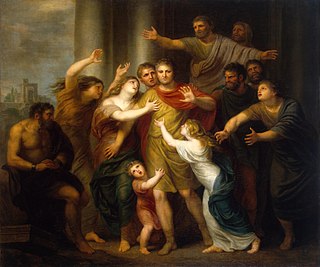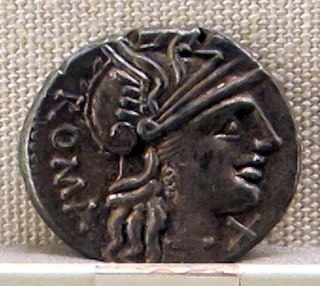
The gens Atilia, sometimes written Atillia, was a plebeian family at ancient Rome, which rose to prominence at the beginning of the fourth century BC. The first member of this gens to attain the consulship was Marcus Atilius Regulus, in 335 BC. The Atilii continued to hold the highest offices of the state throughout the history of the Republic, and well into imperial times.
The gens Papiria was a patrician family at ancient Rome. According to tradition, the Papirii had already achieved prominence in the time of the kings, and the first Rex Sacrorum and Pontifex Maximus of the Republic were members of this gens. Lucius Papirius Mugillanus was the first of the Papirii to obtain the consulship in 444 BC. The patrician members of the family regularly occupied the highest offices of the Roman state down to the time of the Punic Wars. Their most famous member was Lucius Papirius Cursor, five times consul between 326 and 313 BC, who earned three triumphs during the Samnite Wars. Most of the Papirii who held office under the later Republic belonged to various plebeian branches of the family. Although the most illustrious Papirii flourished in the time of the Republic, a number of the family continued to hold high office during the first two centuries of the Empire.
Publius Furius Philus was a consul in 223 BC, a praetor in 216, and a censor in 214. He died the following year, before resigning his office.

The gens Minucia was an ancient Roman family, which flourished from the earliest days of the Republic until imperial times. The gens was apparently of patrician origin, but was better known by its plebeian branches. The first of the Minucii to hold the consulship was Marcus Minucius Augurinus, elected consul in 497 BC.

The gens Postumia was a noble patrician family at ancient Rome. Throughout the history of the Republic, the Postumii frequently occupied the chief magistracies of the Roman state, beginning with Publius Postumius Tubertus, consul in 505 BC, the fifth year of the Republic. Although like much of the old Roman aristocracy, the Postumii faded for a time into obscurity under the Empire, individuals bearing the name of Postumius again filled a number of important offices from the second century AD to the end of the Western Empire.
Lucius Furius Medullinus, of the patrician gens Furia, was a politician and general of the Roman Republic who was consul twice and Consular Tribune seven times.
Gaius Furius Pacilus Fusus was a Roman statesman of the early Republic. He was a descendant of the ancient patrician house of the Furii, which filled the highest offices of the Roman state from the early decades of the Republic to the first century AD. He was probably closely related to Quintus Furius Pacilus Fusus, whom Livy mentions as Pontifex Maximus in 449 BC, and was likely the father of Gaius Furius Pacilus, consul in 412 BC.
Gaius Servilius Ahala was a three time consular tribune of the Roman Republic in 408, 407 and 402 BC. He was also magister equitum in 408 BC.
Gaius Julius Iullus was a Roman statesman and member of the ancient patrician gens Julia. He was consular tribune in 408 and 405 BC, and censor in 393.
Lucius Julius S. f. Vop. n. Iulus was a member of the ancient patrician gens Julia. As consular tribune in 403 BC, he carried on the war with Veii.
The gens Maenia, occasionally written Mainia, was a plebeian family at ancient Rome. Members of this gens are first mentioned soon after the establishment of the Republic, and occur in history down to the second century BC. Several of them held the position of tribune of the plebs, from which they strenuously advocated on behalf of their order. The most illustrious of the family was Gaius Maenius, consul in 338 BC, and dictator in both 320 and 314. In some manuscripts, the nomen Maenius appears to have been erroneously substituted for Menenius or Manlius; there are also instances of confusion with Manilius, Maelius, and Maevius.
Lucius Furius Medullinus was a Roman politician active during the 5th century BC, and was consular tribune in 432, 425, and 420 BC.
Spurius Furius Medullinus Fusus was a Roman politician in the 5th century BC, and was consul in 464 BC, and consul suffect in 453 BC.
Servius Cornelius Maluginensis was a politician and general of the Roman Republic. He was elected consular tribune seven times in 386, 384, 382, 380, 376, 370, and 368 BC. Despite having one of the most successful careers of the Republic, Servius' life is little known.
Titus Quinctius PoenusCincinnatus was a consul of the Roman Republic in 431 and 428 BC and a consular tribune in 426 BC. He might have been consular tribune again in 420 BC.
Quintus Fabius Vibulanus was a consul of the Roman Republic in 423 BC and a consular tribune in 416 and 414 BC.
Lucius Valerius Potitus was a five time consular tribune, in 414, 406, 403, 401 and 398 BC, and two times consul, in 393 and 392 BC, of the Roman Republic.
Manius Aemilius Mamercinus was a three-time consular tribune, in 405, 403 and 401 and also consul in 410 BC, of the Roman Republic.
Lucius Lucretius Tricipitinus Flavus was a Roman statesman and general who had a prominent career in the early 4th century BC, serving once as consul, and four times as consular tribune, as well as perhaps serving as Princeps senatus.
Marcus Furius Fusus was a consular tribune of the Roman Republic in 403 BC.







